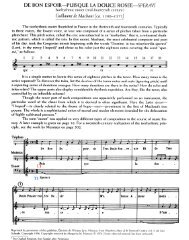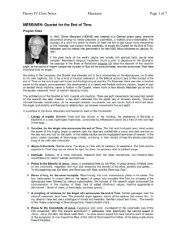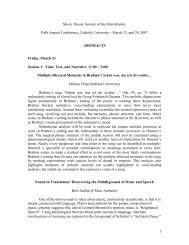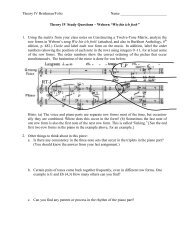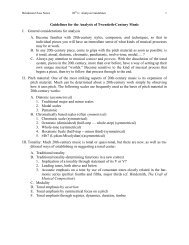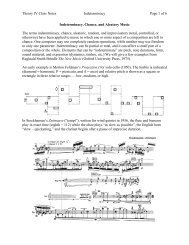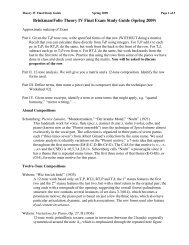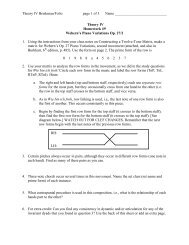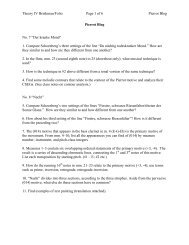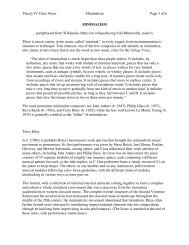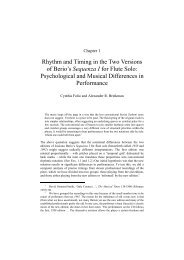Alban Berg, Violin Concerto (1935) from the ... - Temple University
Alban Berg, Violin Concerto (1935) from the ... - Temple University
Alban Berg, Violin Concerto (1935) from the ... - Temple University
Create successful ePaper yourself
Turn your PDF publications into a flip-book with our unique Google optimized e-Paper software.
Theory III Class Notes <strong>Berg</strong> <strong>Violin</strong> <strong>Concerto</strong> Page 1 of 6<br />
<strong>Alban</strong> <strong>Berg</strong>, <strong>Violin</strong> <strong>Concerto</strong> (<strong>1935</strong>)<br />
<strong>from</strong> <strong>the</strong> cover notes for CD SMK 68331 (ADD)<br />
Pinchas Zukerman, <strong>Violin</strong>, London Symphony Orchestra, Pierre Boulez<br />
<strong>Berg</strong> had already acceded to a request by <strong>the</strong> American violinist Louis Krasner to write a violin<br />
concerto, when a shock in <strong>the</strong> circle of <strong>Berg</strong>’s closest friends gave new meaning to a commission<br />
that had been accepted for financial reasons. On April 22, <strong>1935</strong>, Manon Gropius, <strong>the</strong> daughter of<br />
Alma Maler-Werfel <strong>from</strong> <strong>the</strong> latter’s marriage with Walter Gropius, died at <strong>the</strong> age of eighteen.<br />
“Before this terrible year has passed,” <strong>Berg</strong> wrote in a letter to Alma Mahler, “you and Franz<br />
[Werfel] will be able to hear, in <strong>the</strong> form of a score which I shall dedicate to <strong>the</strong> memory of an<br />
angel, that which I feel and today cannot express.” The next weeks were devoted entirely to <strong>the</strong><br />
<strong>Violin</strong> <strong>Concerto</strong>, which was completed by mid-August <strong>1935</strong> — in time for Alma Mahler’s fiftysixth<br />
birthday.<br />
<strong>Berg</strong> confided to his friend and biographer, Willi Reich, that in <strong>the</strong> <strong>Concerto</strong>’s Andante<br />
and Allegretto movements he “had tried to translate <strong>the</strong> young girl’s characteristics into musical<br />
characters.” This first major division of <strong>the</strong> <strong>Concerto</strong> thus contains <strong>the</strong> actual portrait of <strong>the</strong><br />
angelic Manon, whereby <strong>the</strong> Allegretto, as Reich says, “captures <strong>the</strong> vision of <strong>the</strong> lovely girl in<br />
<strong>the</strong> form of a graceful round dance with at times a gentle, dreamlike quality, at times <strong>the</strong> sturdy<br />
unaffectedness of a Carinthian folk tune.” Beginning with a “shriek”, <strong>the</strong> Allegro that introduces<br />
<strong>the</strong> second division conjures up <strong>the</strong> horror of <strong>the</strong> death struggle, broken only by a last<br />
reminiscence of ebbing life. “Groans and shrill cries for help grow in <strong>the</strong> orchestra, to be<br />
smo<strong>the</strong>red by <strong>the</strong> oppressive rhythm of impending ruin” (Willi Reich). With <strong>the</strong> first measure of<br />
<strong>the</strong> following Adagio, <strong>the</strong> solo violin intones <strong>the</strong> chorle “Es ist genug!”, taken by <strong>Berg</strong> <strong>from</strong> <strong>the</strong><br />
collection Sixty Choral Works by Johann Sebastian Bach: <strong>the</strong>re, it closes <strong>the</strong> Cantata O Ewigkeit,<br />
du Donnerwort, BWV 60. The violinist alternates with four woodwinds in playing this melody in<br />
Bach’s original arrangement: “It is enough! Lord, if it be Thy will, give me rest!” Then, in ever<br />
increasing intensity, <strong>the</strong> violin raises its voice in a moving “Song of Woe.” Employing quasidramatic<br />
elements, <strong>Berg</strong> in <strong>the</strong> score instructs <strong>the</strong> soloist to take over <strong>the</strong> leadership of <strong>the</strong> violins<br />
and violas “audibly and visibly.” These are to join him gradually, only to break away <strong>from</strong> him<br />
again “in just a demonstrative a manner.” Toward <strong>the</strong> end of <strong>the</strong> piece, <strong>the</strong> Carinthian folk tune<br />
<strong>from</strong> <strong>the</strong> first part returns “as <strong>from</strong> a great distance.” This melody, a look back on <strong>the</strong> earthly<br />
existence of <strong>the</strong> “sweet girl,” precedes <strong>the</strong> chorale, which reappears one last time in <strong>the</strong> coda:<br />
“Truly, I now go in peace, leaving all my troubles here below. It is enough. It is enough.”<br />
Wolfgang Stähr<br />
Translation © 1995 Griffin Anderson
Theory III Class Notes <strong>Berg</strong> <strong>Violin</strong> <strong>Concerto</strong> Page 2 of 6<br />
Class Notes<br />
<strong>Berg</strong>: <strong>Violin</strong> <strong>Concerto</strong> (<strong>1935</strong>)<br />
The following comes <strong>from</strong> Anthony Pople’s <strong>Berg</strong>: <strong>Violin</strong> <strong>Concerto</strong> (Cambridge <strong>University</strong> Press,<br />
1991):<br />
Movement 1a (Andante)<br />
mm. 1-10 Introduction<br />
11-37 A (aaba)<br />
38-76 B (abab)<br />
77-83 Retransition (using material <strong>from</strong> A)<br />
84-93 A’ (also uses material <strong>from</strong> intro)<br />
94-103 Codetta/Transition (using material <strong>from</strong> intro)<br />
Movement 1b (Allegretto)<br />
104-136 Scherzo (abcba)<br />
137-154 Trio I (aba)<br />
155-166 Trio II (aba)<br />
167-175 Trio I<br />
176-213 Waltz<br />
214-227 Folk Song (‘Ein Vogel auf’m Zwetschenbaum’)<br />
228-257 Coda (using material <strong>from</strong> trios)<br />
Movement 2a (Allegro)<br />
1-22 A<br />
23-43 B<br />
44-60 C (using material <strong>from</strong> Trio II in 1b)<br />
61-77 D<br />
78-95 C (using material <strong>from</strong> Trio II in 1b)<br />
96-124 A’ (with interpolation of B’, mm. 104-119)<br />
125-135 Transition<br />
Movement 2b (Adagio)<br />
136-157 Chorale<br />
158-177 Variation I<br />
178-199 Variation II<br />
200-213 Folk Song (‘Ein Vogel auf’m Zwetschenbaum’)<br />
214-230 Coda (includes material <strong>from</strong> Introduction in 1a)
Theory III Class Notes <strong>Berg</strong> <strong>Violin</strong> <strong>Concerto</strong> Page 3 of 6<br />
Texts of <strong>the</strong> two “found objects” in <strong>the</strong> concerto:<br />
‘Ein Vogel auf’m Zwetschgenbaum’<br />
(Carinthian Folk Melody)<br />
A bird on <strong>the</strong> plum tree has wakened me,<br />
Tridie, tridie, iri, tulie!<br />
O<strong>the</strong>rwise I would have overslept in Mizzi’s* bed,<br />
Tridie, ri, tulie!<br />
If everybody wants a rich and handsome girl,<br />
Tridie, tridie, iri, tulie!<br />
Where ought <strong>the</strong> devil take <strong>the</strong> ugly one?<br />
Tridie, ri, tulie!<br />
The girl is Catholic and I am Protestant,<br />
Tridie, tridie, iri, tulie!<br />
She will surely put away <strong>the</strong> rosary in bed!<br />
Tridie, ri, tulie!<br />
* ”Mutzi” was Manon’s nickname. “Mizzi” Scheuchl was a girl in <strong>the</strong> employ of <strong>Berg</strong>’s parents;<br />
he fa<strong>the</strong>red a child by her when he was 17.<br />
‘Es ist genug!’<br />
(<strong>from</strong> J. S. Bach: Cantata BWV 60)<br />
It is enough!<br />
Lord, when it pleases Thee,<br />
Relieve me of my yoke!<br />
My Jesus comes:<br />
So goodnight now, O world!<br />
I’m going to my Heavenly home.<br />
I’ll surely journey <strong>the</strong>re in peace,<br />
My great distress will stay below.<br />
It is enough.<br />
It is enough.
Theory III Class Notes <strong>Berg</strong> <strong>Violin</strong> <strong>Concerto</strong> Page 4 of 6<br />
<strong>Berg</strong> inscribed <strong>the</strong> <strong>Violin</strong> <strong>Concerto</strong> “dem Andenken eines Engels” (‘to <strong>the</strong> memory of an angel”).<br />
It was written on <strong>the</strong> death of Manon Gropius, <strong>the</strong> daughter of Alma Mahler and Walter Gropius,<br />
of poliomyelitis in April of <strong>1935</strong>. <strong>Berg</strong> himself died in December of <strong>1935</strong>, shortly before <strong>the</strong><br />
premiere of <strong>the</strong> concerto, of septicaemia resulting <strong>from</strong> an insect sting he received at <strong>the</strong> base of<br />
his spine in July of <strong>the</strong> same year.<br />
The following is <strong>the</strong> “program” of <strong>the</strong> work, produced by Willi Reich and overseen by <strong>Berg</strong>:<br />
“Insofar as a transcription into words is possible at all, <strong>the</strong> ‘tone’—a favorite expression of <strong>Berg</strong>’s—of <strong>the</strong><br />
whole work may be described as follows: delicate Andante melodies emerge <strong>from</strong> <strong>the</strong> rising and falling movement<br />
of <strong>the</strong> introduction. These crystallise into a Grazioso middle section and <strong>the</strong>n dissolve back into <strong>the</strong> waves of <strong>the</strong><br />
opening. The Allegretto Scherzo rises <strong>from</strong> <strong>the</strong> same background; this part captures <strong>the</strong> vision of <strong>the</strong> lovely girl in a<br />
graceful dance which alternates between a delicate and dreamy character and <strong>the</strong> rustic character of a folk tune. A<br />
wild orchestral cry introduces <strong>the</strong> second main part, which begins as a free and stormy cadenza. The demonic action<br />
moves irresistibly towards catastrophe, interrupted once—briefly—by a reversed point of rest. Groans and strident<br />
cries for help are heard in <strong>the</strong> orchestra, choked off by <strong>the</strong> suffocating rhythmic pressure of destruction. Finally:<br />
over a long pedal point—gradual collapse. At <strong>the</strong> moment of highest suspense and anxiety, <strong>the</strong> Chorale enters,<br />
serious and solemn, in <strong>the</strong> solo violin. Like an organ <strong>the</strong> woodwinds answer each verse with <strong>the</strong> original<br />
harmonization of <strong>the</strong> classical model. Ingenious variations follow, with <strong>the</strong> original Chorale melody always present<br />
as a cantus firmus, climbing ‘misterioso’ <strong>from</strong> <strong>the</strong> bass while <strong>the</strong> solo violin intones a ‘plaint’ [Klagegesang] that<br />
gradually struggles towards <strong>the</strong> light. The dirge grows continually in strength; <strong>the</strong> soloist, with a visible gesture,<br />
takes over <strong>the</strong> leadership of <strong>the</strong> whole body of violins and violas; gradually <strong>the</strong>y all join in with his melody and rise<br />
to a mighty climax before separating back into <strong>the</strong>ir own parts. An indescribably melancholy reprise of <strong>the</strong> folk tune<br />
‘as if in <strong>the</strong> distance (but much slower than <strong>the</strong> first time)’ reminds us once more of <strong>the</strong> lovely image of <strong>the</strong> girl; <strong>the</strong>n<br />
<strong>the</strong> Chorale, with bitter harmonies, ends this sad farewell while <strong>the</strong> solo violin arches high over it with entry after<br />
entry of <strong>the</strong> plaint.”<br />
The folk tune (‘Ein Vogel auf’m Zwetschgenbaum’):<br />
The beginning of <strong>the</strong> row (next page) alternates minor and major triads, and notes 1, 3, 5, 7 are<br />
<strong>the</strong> open strings of <strong>the</strong> violin (used in <strong>the</strong> beginning of <strong>the</strong> concerto). The last four notes, a<br />
whole-tone segment, suggest <strong>the</strong> beginning of <strong>the</strong> chorale, “Es ist genug.” (See page 6)
Theory III Class Notes <strong>Berg</strong> <strong>Violin</strong> <strong>Concerto</strong> Page 5 of 6<br />
The row:<br />
0 3 7 B 2 5 9 1 4 6 8 A<br />
9 0 4 8 B 2 6 A 1 3 5 7<br />
5 8 0 4 7 A 2 6 9 B 1 3<br />
1 4 8 0 3 6 A 2 5 7 9 B<br />
A 1 5 9 0 3 7 B 2 4 6 8<br />
7 A 2 6 9 0 4 8 B 1 3 5<br />
3 6 A 2 5 8 0 4 7 9 B 1<br />
B 2 6 A 1 4 8 0 3 5 7 9<br />
8 B 3 7 A 1 5 9 0 2 4 6<br />
6 9 1 5 8 B 3 7 A 0 2 4<br />
4 7 B 3 6 9 1 5 8 A 0 2<br />
2 5 9 1 4 7 B 3 6 8 A 0<br />
<strong>Berg</strong> often explicitly uses <strong>the</strong> tonal potential of <strong>the</strong> row (mm. 11-14 of 1a):<br />
And often uses row forms in unusual ways (as in <strong>the</strong> production of <strong>the</strong> ‘Klagegesang’):<br />
*<strong>the</strong> last four notes of T3P are heard at <strong>the</strong> beginning of <strong>the</strong> row.
Theory III Class Notes <strong>Berg</strong> <strong>Violin</strong> <strong>Concerto</strong> Page 6 of 6



